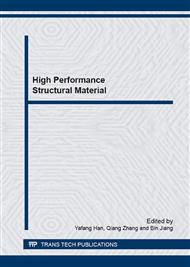p.715
p.722
p.729
p.736
p.743
p.750
p.755
p.761
p.769
Effect of Rolling Process on Impact Toughness in High Strength Low Carbon Bainitic Steel
Abstract:
Based on TMCP and UFC technology, the microstructures and impact toughness of low carbon bainitic steel were studied in this paper. The bainite morphology and fracture surfaces of Charpy impact specimens were observed by SEM, and mechanical properties of bainitic steel were measured by tensile and impact test. The results showed that the yield and tensile strengths of steel were 804MPa and 1015MPa, and elongation was 15.7% when the rolling was finished in the austenite recrystallization region. The steel rolled below Tnr temperature obtained tht yield strength of 930 MPa, tensile strength of 1090 MPa and elongation of 16.2%. However, the impact toughness was deteriorated in the steel rolled above Tnr temperature while the excellent impact toughness existed in the steel rolled below Tnr temperature. The impact toughness of steel rolled below Tnr temperature was 140J at-60°C, while the impact toughness of 15J at the same temperature was obtained for the steel rolled above Tnr temperature. The large cleavage fracture region on the fracture surface occured with the decrease of tested temperature in the steel rolled above Tnr temperature and inevitably reduced the impact toughness, while the main ductile fracture existed in the steel rolled below Tnr temperature at the same temperature. The rolling process of steel can strongly affect impact toughness of low carbon bainitic steel. Hence, the different rolling processes can adjust the occurrence of cleavage fracture and ductile fracture in order to improve the impact toughness.
Info:
Periodical:
Pages:
743-749
Citation:
Online since:
April 2015
Authors:
Price:
Сopyright:
© 2015 Trans Tech Publications Ltd. All Rights Reserved
Share:
Citation:


